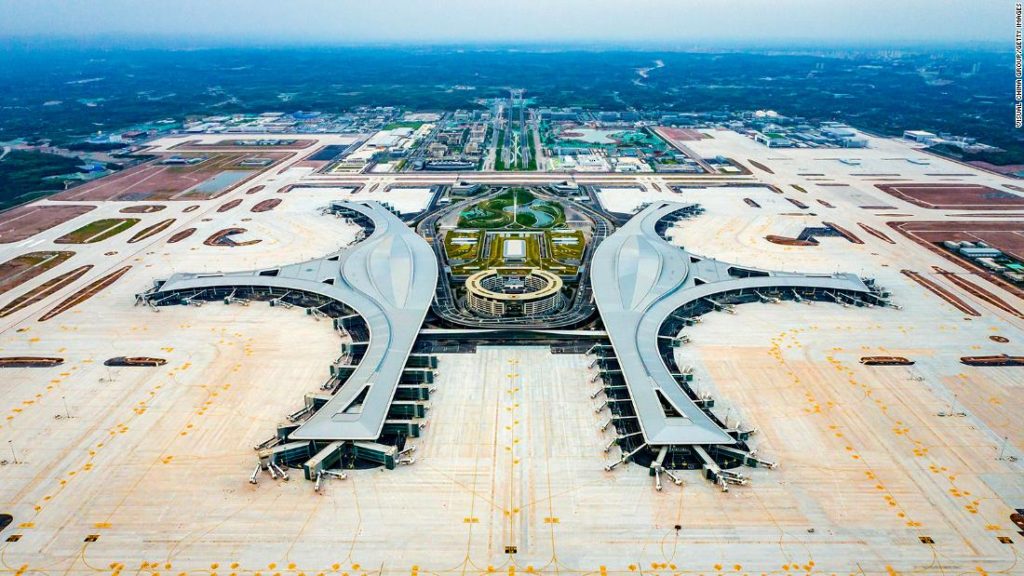(CNN) — China’s long-awaited Chengdu Tianfu International Airport has officially begun operations, offering travelers a new gateway to the home of giant pandas.
Its inaugural flight, operated by Sichuan Airlines, took off at 11:10 a.m. on Sunday, bound for Beijing.
Chengdu, the capital of Sichuan province, is now the third city in the country to have two international airports, joining Shanghai and Beijing.
Constructed at a cost of about 70 billion Chinese yuan ($10.8 billion), phase one of the massive aviation hub has the capacity to handle up to 60 million passengers per year, further opening up the country’s southwest region.
Three runways and two terminals, covering a total area of 710,000 square meters, are in operation. State media outlet Xinhua reported the airport will eventually house terminals covering 1.4 million square meters, capable of handling 120 million passengers annually.

Passengers prepare to board an airplane at Chengdu Tianfu International Airport on June 27.
Visual China Group/Getty Images
In addition to the famous pandas, Sichuan is famous for its spicy cuisine and beautiful scenery, making it one of China’s most-popular tourist destinations among both domestic and international tourists.
For now, however, the new airport will only be catering to the former. China remains closed to most international travelers.
“The new airport in Chengdu was needed to accommodate continued rapid growth,” said aviation analyst Brendan Sobie. “China’s domestic market has already fully recovered from the pandemic and will continue to grow rapidly. Given the size of the city and its central location in China, Chengdu is very well-positioned to benefit.”
Prior to the pandemic, the old Chengdu Shuangliu International Airport was the fourth-largest in the country, by passenger volume. In 2020, “it was actually the second largest as it was less impacted by the pandemic than other major airports due to its high reliance on the domestic market,” adds Sobie.
China’s airport ambitions
The new Chengdu Tianfu International Airport was designed by a consortium made up of the China Southwest Architectural Design and Research Institute, China Airport Construction Group Corporation and French architectural firm ADP Ingenierie.
Phase one took five years to complete and features an array of cutting-edge technologies, including facial recognition software, self-check-in kiosks, smart security systems, self-boarding gates and AI robot concierges.
A metro line connects the airport with the city center. Hitting speeds of up to 140 kilometers per hour, the train journey takes from 37 to 44 minutes. A metro line connecting the new facility to the Chengdu Shuangliu International Airport is due for completion in 2023.
CNN’s David Culver tours the new starfish-shaped Daxing airport, boasting customer service robots and a terminal the size of 97 soccer fields.
Chengdu Tianfu International Airport is just one of many airports China plans to open in the coming years.
The country aims to have 400 airports in use by 2035, a huge leap from the current 241, according to the Transportation Network Planning Outline issued by the government in early 2021.
Prior to its opening, the city had been in desperate need of a second global gateway. The Beijing Capital International Airport (PEK) was the world’s second-busiest aviation hub and hitting full capacity, making it nearly impossible for airlines to add flights at desirable times.
CNN’s Maggie Hiufu Wong and Shawn Deng contributed to this report.
You may also like
-
Afghanistan: Civilian casualties hit record high amid US withdrawal, UN says
-
How Taiwan is trying to defend against a cyber ‘World War III’
-
Pandemic travel news this week: Quarantine escapes and airplane disguises
-
Why would anyone trust Brexit Britain again?
-
Black fungus: A second crisis is killing survivors of India’s worst Covid wave

